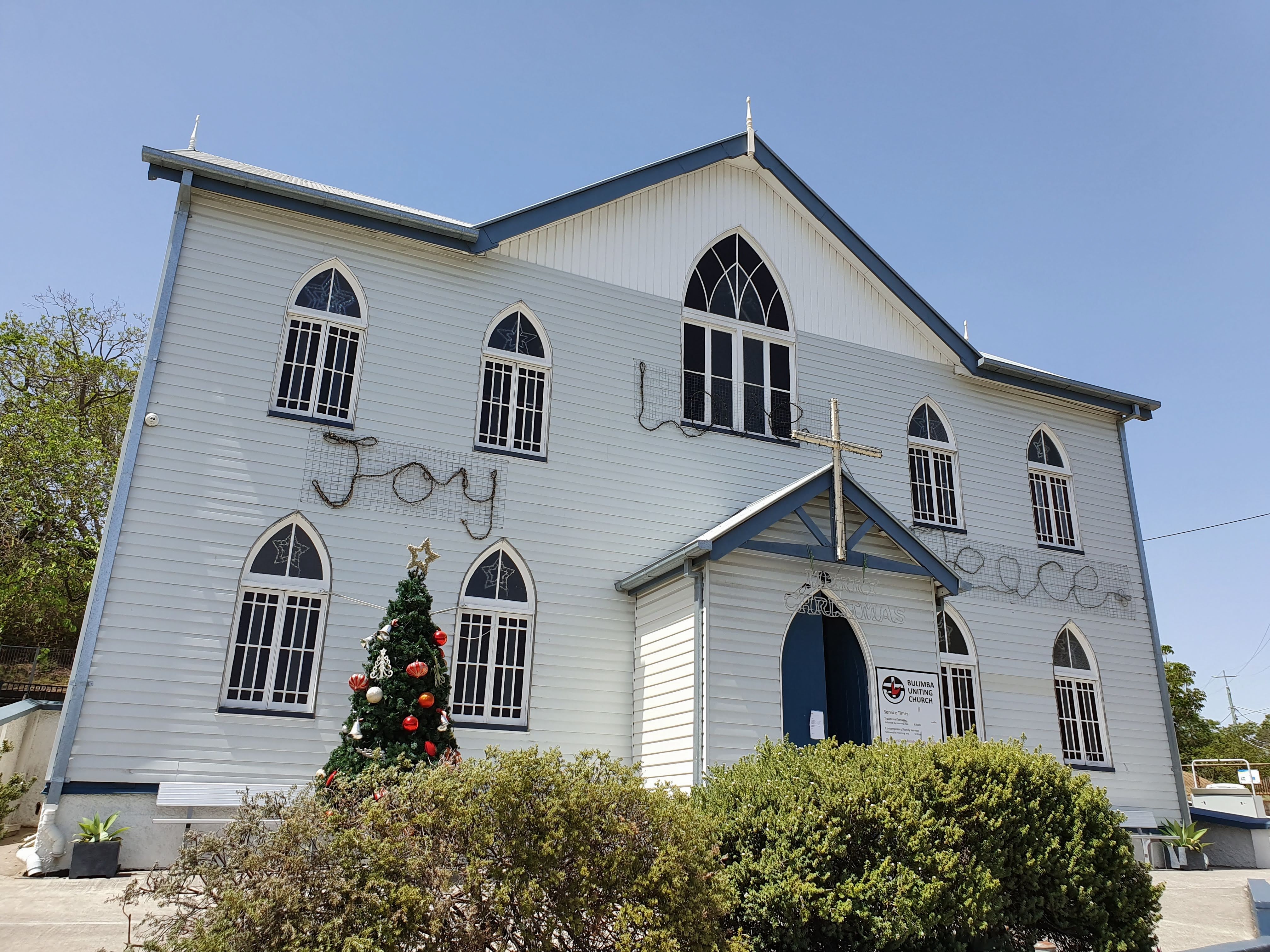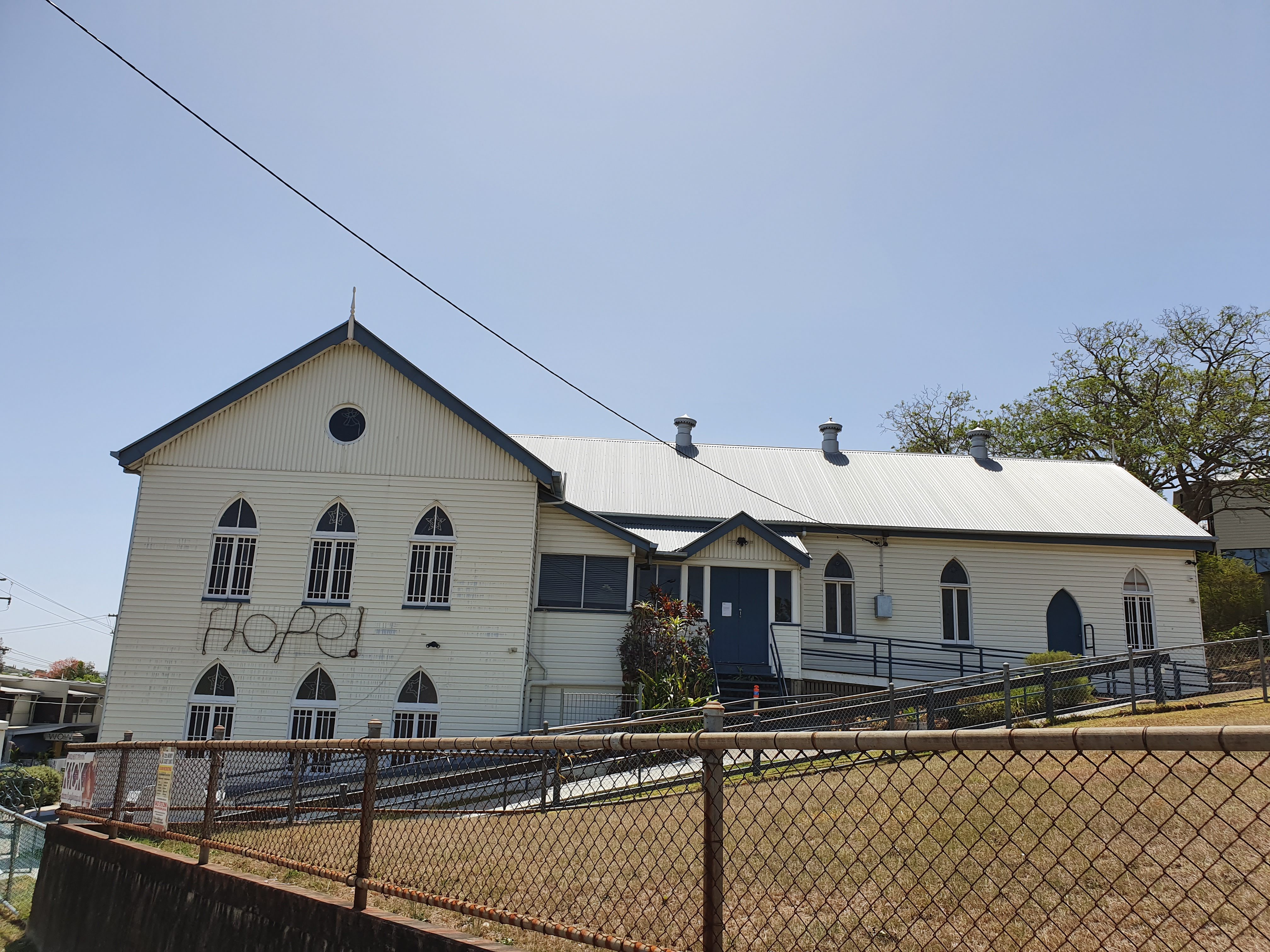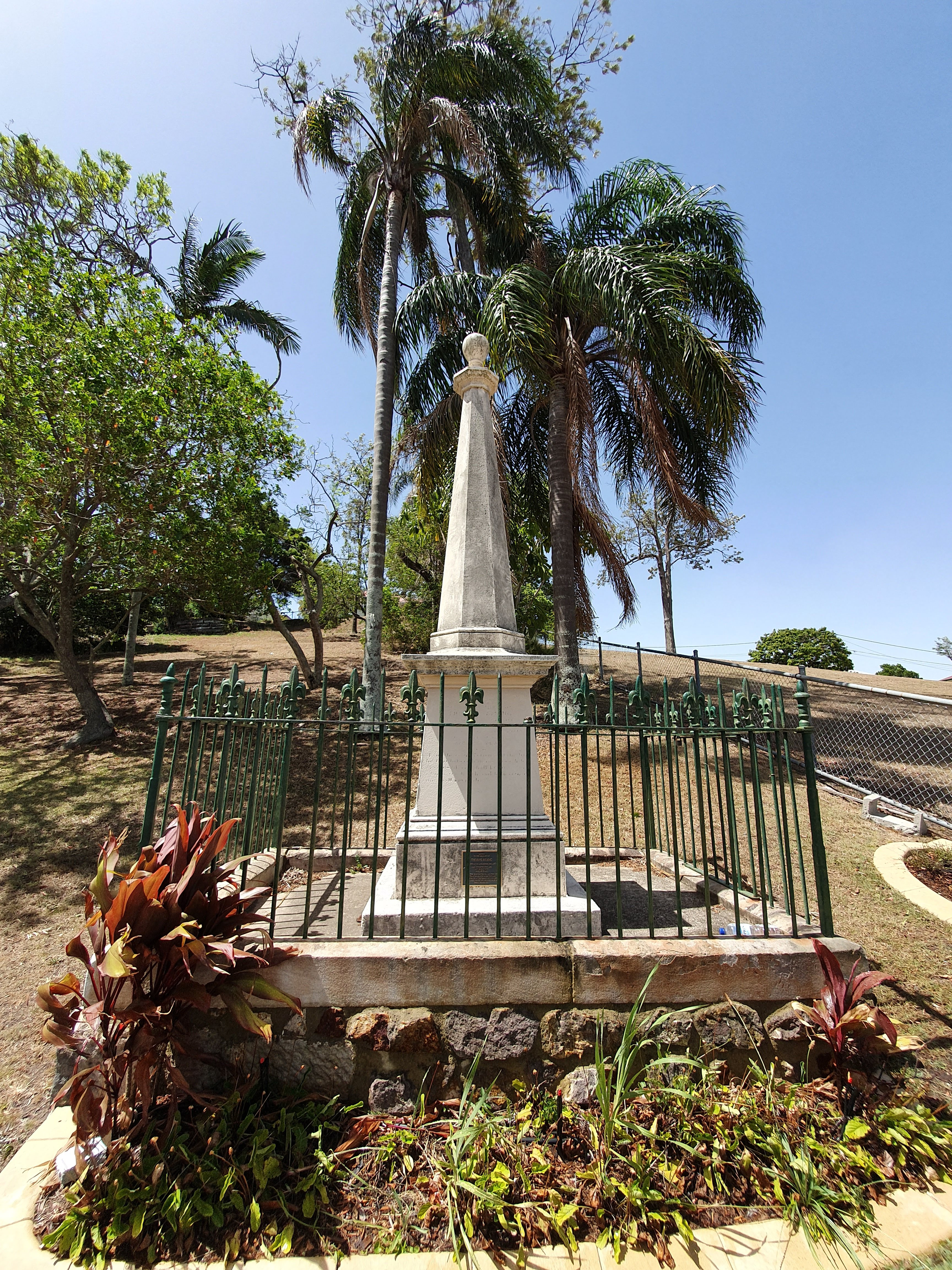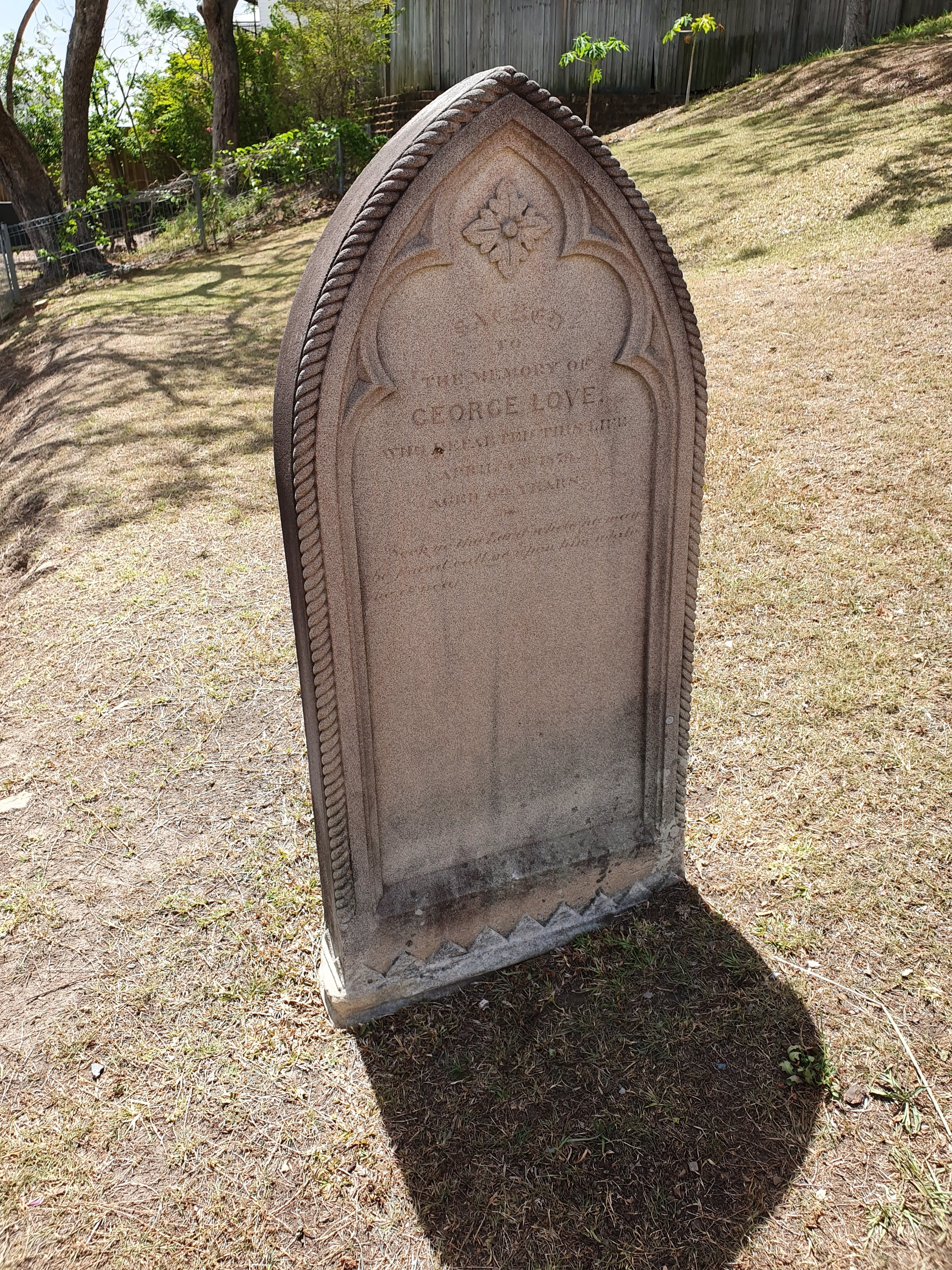Addresses
Type of place
Church
Period
Victorian 1860-1890, Interwar 1919-1939
Style
Carpenter Gothic
Addresses
Type of place
Church
Period
Victorian 1860-1890, Interwar 1919-1939
Style
Carpenter Gothic
The Bulimba Uniting Church is an outstanding local landmark. It was originally opened as a Primitive Methodist Church in 1866 and was the first church to be built in the Bulimba district. An increase in the local population in the early twentieth century saw the church extended in 1926. Having served as both a Methodist and Uniting church, it has been a focus for community worship for more than 140 years. Displaying the principal characteristics of Carpenter Gothic style architecture, this church makes a strong aesthetic contribution to the streetscape and has both spiritual and social significance for generations of Bulimba residents.
Also known as
Bulimba Methodist Church
Lot plan
L1_RP12632; L4_RP12641
Key dates
Local Heritage Place Since —
Date of Citation —
Construction
Roof: Corrugated iron;Walls: Timber
People/associations
William Thorpe Riding (Association)Criterion for listing
(A) Historical; (B) Rarity; (D) Representative; (E) Aesthetic; (G) Social; (H) Historical associationInteractive mapping
Also known as
Bulimba Methodist Church
Lot plan
L1_RP12632; L4_RP12641
Key dates
Local Heritage Place Since —
Date of Citation —
Construction
Roof: Corrugated iron;Walls: Timber
People/associations
William Thorpe Riding (Association)Criterion for listing
(A) Historical; (B) Rarity; (D) Representative; (E) Aesthetic; (G) Social; (H) Historical associationInteractive mapping
History
European occupation of the Bulimba area dates from the late 1840s when David McConnell built Bulimba House on the 121 acres of Bulimba Point purchased shortly after Moreton Bay was opened to free settlement in 1842. By the 1850s the McConnell’s and their employees were joined by other scrub farms owned by the Johnston, Thorpe Riding, Watts, Smith and Challenger families. While the McConnell’s hosted early educational classes and religious services in their home, the first Primitive Methodist Congregation met "in the shade of a large tree which stood midway between the Bulimba Ferry and the site of the present church" and also temporarily in a tent.
During the 1860s the European population at Bulimba increased with further sales of land. Allotments originally granted to McConnell, Johnston and Thorpe Riding were subdivided and sold from 1865. William Thorpe Riding donated the land on which the Uniting Church now stands as a site for a church. William Thorpe Riding and his wife, who both died in 1877 are buried in the grounds of the church.
The original rear part of the church was opened on Good Friday, 30 March 1866. The Episcopal congregation did not regard Good Friday as a day of worship, so the opening ceremony was held as a meeting. Mr W. Payne presided at the meeting that was also attended by Rev Joseph Buckle, who had held the first services in the district assisted by Mr Payne. About 200 people attended the opening including prominent laymen. The Brisbane Courier commented at the time that the new Primitive Methodist Church "is a neat edifice, and a credit to the district and to the denomination who own it."
The church was originally established as a branch of the Leichhardt Street circuit, which at the time was the only Primitive Methodist Circuit in Brisbane. Later the Bulimba Church with the Brunswick Street Church formed the New Farm circuit until 1913 when the Balmoral circuit, comprising churches at Morningside, Tingalpa, Cannon Hill, Murarrie and Bulimba was formed.
The residential development of the district, evident in the formation of these nearby churches, also placed increased demands on the Bulimba Church. In the 1920s the growth in the population, and especially the number of young people, necessitated the enlargement of the old church. For the sixtieth anniversary in 1926 a large two storeyed building was added at the front of the original church. The Methodist Times reported that the extension "is of attractive design, adding considerably to the design of the church". Its lower storey was used as a kindergarten, while the upper storey provided an enlarged church. The additions cost £1600, the debt being reduced to £140 by 1936 despite the Depression of the 1930s. Perhaps this was due to the fact that from 1907, parishioners had been “encouraged to give one penny a week towards church funds” The extensions were made possible by the acquisition of adjacent land at both sides of the church and were opened by Mrs. Moses Ward, a descendant of Thorpe Riding. Improvements were made to the church in the 1950s, including the installation of a Hammond Electric Organ at a cost of £878 and repainting the roof.
In 1966, the property board of the Bulimba Methodist Church proposed to demolish the timber structures and “erect a complex of buildings for Worship and other Church life activities… and to dedicate these buildings for a perpetuation of memory of the pioneers of the Bulimba District.” Architects Kirkegard and Ellwood developed the plans for the new complex, which was estimated to cost $54,100. The building did not proceed.
In 1928 a parsonage at Emerald Hill was removed to a position near the church and re-erected at a cost of £1000, including furnishings.
The Bulimba Methodist congregation embraced the 1977 union of the Presbyterian, Congregationalist and Methodist churches and the building is now a Uniting Church continuing to serve as a focus for the local community. Worship services are now held in the original church building.
Description
This Victorian Carpenter Gothic style church is prominently located near the intersection of Oxford Street, Riding and Hawthorne Roads on a steeply sloping site. A small graveyard containing the remains of the church's benefactor Mr Thorpe Riding and his wife is located at the rear of the church.
The building is generally T-shaped in plan form due to the 1926 two storey addition to enlarge the church. A later extension of the eastern side to provide additional accommodation and enclosure of the entry porch has also been provided.
Apart from this small extension and enclosure of the entry porch and recent overall cladding of the external walls with metal sheeting, the building essentially looks as it did in 1936.
The entire building is constructed in timber framing and would have originally been clad with weatherboards. The building is now sheeted with metal cladding to replicate chamferboard and vertical boarding to the gable ends. Timber window sills, fascia boards and eaves linings have also been clad with metal sheeting.
The original rear section of the building is supported on concrete stumps whilst the newer two storey front section rises from a brick base to which a stucco plaster facing has been applied.
All roofs are sheeted with corrugated iron. Ventilation to the roof space of the rear section is provided by three metal roof ventilators mounted on the apex. Additional ventilation is provided by a fixed timber louvred vent mounted in the gable of the rear (northern) wall.
Access to the church (nave) is by means of a ramp and set of timber steps leading to the entry porch on the eastern side of the building. This porch would most probably have been open but enclosed when other recent adjacent extensions were undertaken.
Other access to the nave is provided by doorways located towards the northern end. Due to the terrain of the site these doorways are accessed by small flights of timber framed steps.
All doors are framed vertical joint and generally incorporate a pointed arched head.
Windows are generally timber framed casements (in pairs) with a fixed fanlight in the shape of a pointed arch. Window panes are generally plain obscure or coloured glass with the nave windows to the rear section being lead lighted. The two windows in the northern wall are hoppers fitted with opaque glass.
The small eastern side extension is timber framed, sheeted with metal (chamferboard) cladding, roofed with a corrugated iron skillion roof and glazed with clear sliding glass in aluminium frames.
Each apex at the gable end is terminated with a shaped timber finial.
The building is generally devoid of decoration apart from a tracery type pointed arch fanlight to a large central window on the southern wall and a king post truss and timber cross gable framing over the lower floor attached entry porch.
Statement of significance
Relevant assessment criteria
This is a place of local heritage significance and meets one or more of the local heritage criteria under the Heritage planning scheme policy of the Brisbane City Plan 2014. It is significant because:
References
-
Brisbane Courier, Saturday, 31 March 1866
-
Courier Mail, Saturday, 16 May 1936 and 1967
-
Jack, S.W., Cutting Book, no. 6, p.3 (cutting date 19-5-36), manuscript, JOL
-
Methodist Times, 28 May 1936
-
A Memorial to the Pioneers of the Bulimba District, 1966, Booklet provided by the Bulimba Uniting Church
-
Faith in Action, Balmoral Methodist Circuit, brochure, 1963
Citation prepared by — Brisbane City Council (page revised September 2020)




